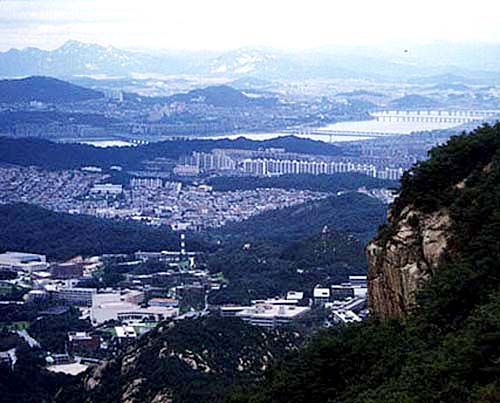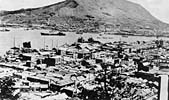
|
|
|
|
|
|
|
|
|
|
|
|
|

In the words of Robert T.Oliver, author of A History of The Korean
People In Modern Times, “To know what Koreans are like, it is necessary
to know what they have been (through) and how, step by step, they have
gotten from where they were to where they are now,” indicates that the
Korean people live their present day lives as a reflection of their past.
A past that will never let the people of Korea forget the turmoil and depression
that they had undergone. Yet, at the same time, in an article in Time Asia
Magazine, written on the 29th of January, 2002, Korea has captured a new
slogan for herself: “Dynamic Korea.” In the following report,
an account will be told of the history of Korea with respect to the war
between the United States and the Soviet Union that divided Korea into
two warring bodies and one common goal: a search for a Seoul.
There are early indications that Korea was colonized in the Old Stone Age, but today, Koreans probably came from the Paleo-Asian peoples of the Younger Stone Age. Korea’s Creation Myth began in 2333 BC by a demagoge, Tangun, originator of the Tung-I people, founding the ‘Ancient Choson’ Empire. Ancient Choson is known as “Land of the morning calm.” The story of the Ancient Choson represents a connection, a relationship, between the human race and the gods and nature.
Although the Koreans ethnically belong to the Mongolian race, they still posses their own language, traditions, and culture, which have been different from their neighbors China and Japan for a very long time. However, due to their historic experiences, the Koreans faced the dreaded aftermath of World War II, leaving them confused about their future, like pieces of a puzzle waiting to be put together.
The surrender of Japan was inevitable in August 1945 after the United States dropped the first atomic bomb on Hiroshima. Stalin, Russia’s President, patiently waited for such the opportunity where the Soviets could enter the war against Japan. When the U.S. dropped the second bomb, Stalin stepped in and declared war on Japan. On the 15th of August, the Japanese admit defeat, and the Soviet military marched through Manchuria and North Korea, seizing what ever provisions the Japanese once controled. The United States, seeing what was going on, was alarmed, and recognized the potential danger of Communism controlling Korea. President Truman, of the United States, proposed that the two powers, Soviet and the U.S., have a joint occupation of Korea. Thus, the division was made, drawn on the thirty-eighth parallel: the Soviets would take the North territory, while the U.S. acquired the South. These two separate states are the residue of the Cold War (Myers, 1).
 With
forces from the area. In spite of this, neither the Soviet Union
nor the United States wanted the whole of Korea to fall into the other’s
hand completely. Therefore, both came to an agreement to withdraw
their military forces out of Korea, but they also wanted to leave Korea
in favor of each of their own ideology. The United States wanted
a democratic nation to be established in Korea whereas the Soviet Union
longed for a Communist Korea.
With
forces from the area. In spite of this, neither the Soviet Union
nor the United States wanted the whole of Korea to fall into the other’s
hand completely. Therefore, both came to an agreement to withdraw
their military forces out of Korea, but they also wanted to leave Korea
in favor of each of their own ideology. The United States wanted
a democratic nation to be established in Korea whereas the Soviet Union
longed for a Communist Korea.
After the agreement had been met, the Communists led the North while the U.S. influenced the South. Communist elements in the North were present during the early Japanese occupation, but with the north under Soviet control, the leftist factions were able to seize power. So be it that during this time, that the Soviets help institute Kim II Sung, as the political figure in the north. However, in the south an entirely different influence began to unravel.
The Korean People’s Republic (KPR), leftist by nature, said that they were the political voice of the Korean people. But the U.S. did not want the Communist takeover of South Korea so they banned the KPR. At the same time as this was happening, a Korean patriot by the name of Syngman Rhee began to acquire political power among the conservatives in South Korea. Due to his outrageous advocacy for Korea’s independence often caused a friction between him and the U.S. officials. But because of his strong stance against communism, and commitment to maintaining order, he was given support by the U.S. Therefore, by 1947, with the support of the U.S., Symgman Rhee became the political leader in South Korea.
Although both the North and the South had each a political government, the fact still remained that they were only provisional governments. This still gave rise to the idea of ‘hope’ for a unified Korea. And even at this time, in 1947, nationalists from both sides continued to show efforts of negotiation for a unification. Least to say that has yet to have been reconciled. The differences between the U.S. and the Soviet Union are still prevalent. And though these differences exist, the U.S. allowed Korea to have an election that would come from the people of Korea. The U.S. pushed for the United Nations to allow this general election. Yet the U.S. still smelled foul play on the Soviets part and made sure that the elections were to be held in South Korea. Nonetheless, North Korea acted in a similar fashion by and held its own elections. Soon Kim II Sung was elected president of the New Democratic People’s Republic of Korea (DPKR). The Soviet Union recognized him as the lawful government leader of North Korea. And so, by the end of 1948, it had been made affirmed to the Korean Nationalist that the thirtieth-eighth parallel remained permanently divided.
On the 13th of July, 1953, the Korean War was “halted,” not “terminated.” The war ended with a “truce” and not a peace treaty. This permanent division at the invisible line became the warring ground in which people live. As the feud between the United States and the Soviet Union went on, both being “foreigners” to this foreign land, put aside the most important aspect of Korea that mattered--the people. This division and warring over Korea left the Korean people nothing but sadness and depression. But one thing is for certain, there is this inclination of ‘hope’ that the people of Korea has. This hope of one day of unification of both Koreas. Koreans are a sturdy people with a stubborn core of undefeatable “Koreanism.” They are zealous individuals, united in pride in their traditions, but divided by clannish contentiousness (Oliver, 19). Korea is a striving nation. It is necessary now is for Korea to come to terms and claim its own identity as one nation. It is very important for a country to find their identity and establish it. However, it is also a hard thing to do when for a long time a country seems to live day in and day out with the mentality that has been well established for the people and by the people. This mentality is of repression, suppression, and of old ways. Needless to say, Korea can be this Dynamic Nation, as long as the common goal for both Koreas is to work towards terms of unification.
Cummings, Bruce. Korea’s Place In The Sun: A Modern History. New York: W.W. Norton & Company, 1997.
Gale, James Scarth. History of The Korean People. Seoul, Korea: Royal Asiatic Society, Korea Branch and Taewon Publishing Company, 1972.
Leeke, Ada E. When Americans Came To Korea. La Jolla, California: Pine Hill Press, 1991.
Myers, Robert J. Korea In The Cross Currents: A Century of Struggle and The Crisis of Reunification. New York: Palgrave, 2001.
Oliver, Robert T. A History of The Korean People in Modern Times: 1800 To The Present. Newark: University of Delaware Press, 1993.
http://www.lifeinkorea.com/information/history1.cfm (history, life in Korea, and pictures)
http://www.maxuk.net/koreajapan/index.shtml (history)
http://www.kois.go.kr/ (history and pictures)
http://www.knto-th.org/ (history)
TIMEasia.com/travelwatch05/03/99
(articles on life in Korea, modern Korea, and pictures)
Site Created by:
Janelle Agulo